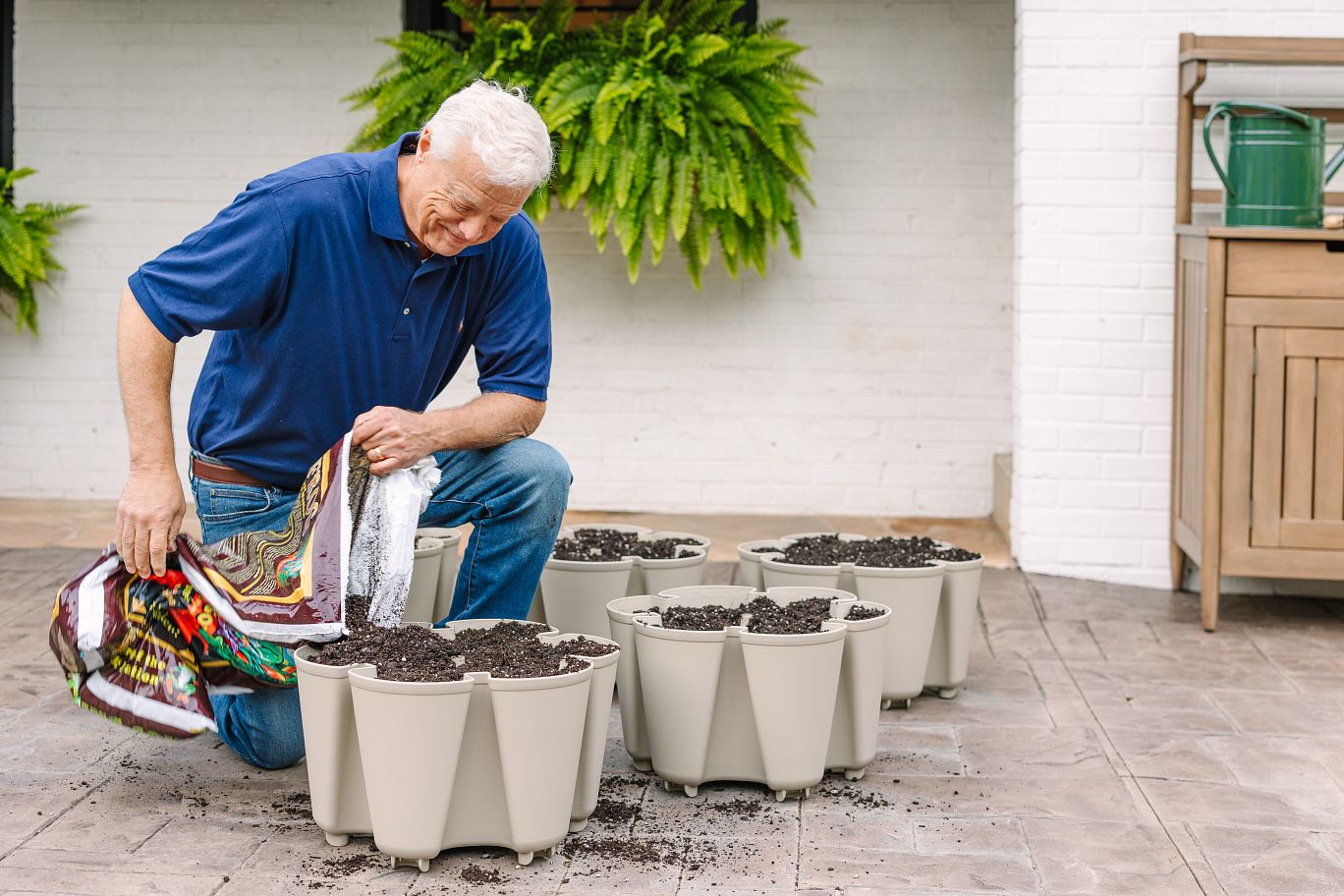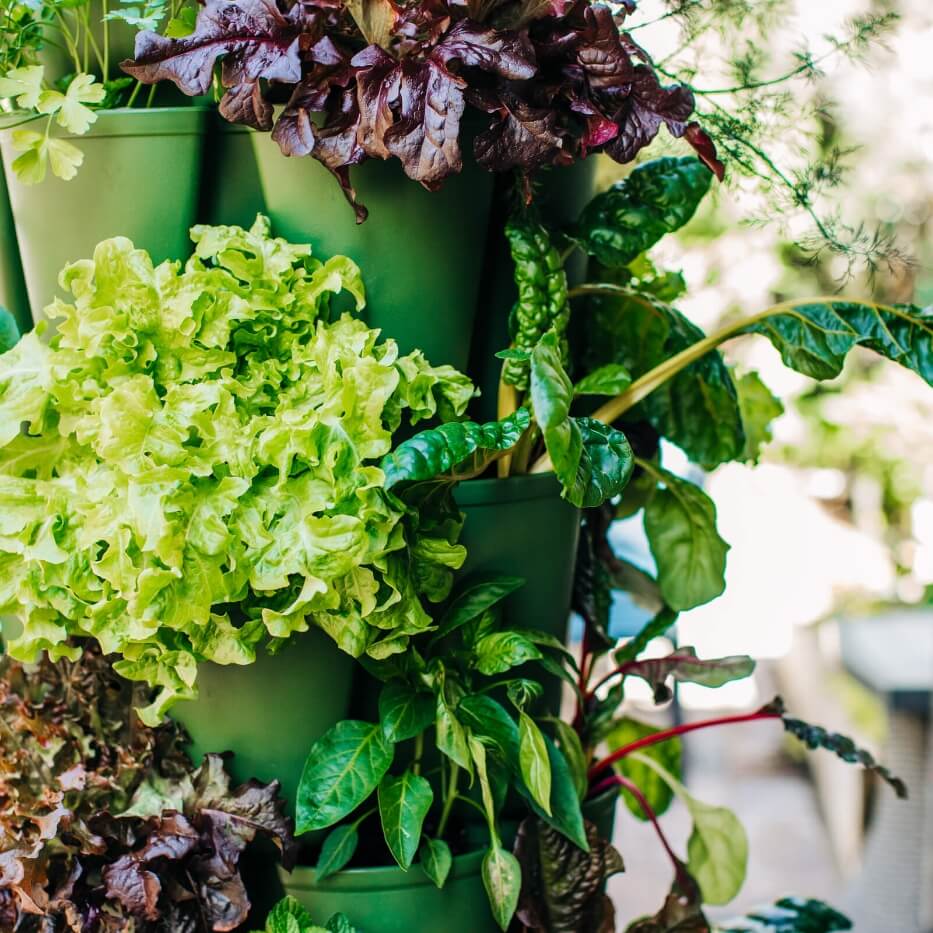We at GreenStalk know that gardening, while fun and rewarding, can quickly become an expensive venture. However, you’ve come to the right place. We’ll share some of our favorite tips for how to save money in your GreenStalk Vertical Garden.
Start from seed
One of the easiest ways to save money is to start from seed. You can direct sow into your GreenStalk or start seeds indoors and transplant young plants. Financial considerations aside, we like planting from seed because there are generally more varieties of seeds available online than the starter plants offered at your local nursery.
Also, consider swapping with a friend. You may not need all 50+ tomato seeds that come in a package. A local gardening friend or neighbor may not need all 50+ of their pepper seeds. So plan your gardens together and swap! Growing with friends is more fun anyway.

Sowing seeds is often more affordable than starter plants and offers more plant varieties.
Save seeds
Once those plants are fully mature: save the seeds! Don’t let the idea of saving seeds be too intimidating. Once you understand the basics, you’ll be hooked.
For flowers or flowering vegetables like lettuce or spinach, just let one plant’s flowers wither back and dry out fully. Holding an envelope or piece of paper under the flower, carefully pull it from the plant. For some flowers, the seeds might spill out right away. Some need to be gently released by rolling the pod between your thumb and forefinger.
For other fruits and vegetables that contain the seeds in the fruit flesh, like tomatoes, squash, or beans, separate the seeds from the fruit. Rub them gently with a paper towel and let them air dry for a couple of weeks. Then store them in a paper envelope, ensuring they get a little airflow but no moisture.
Pod plants like peas and beans are easiest because the seeds are larger and easy to handle. Leave the pods on the vine until the beans are large and bulging or fully dried out, then bring them inside. Now you’ll have some free seeds for the next growing season… and don’t forget to share a few with a friend!
Don’t forget to label the plant name, variety, and year of harvest on all of your home-saved seed packets. Seeds can last for a few years but the germination rate may decline after the first year.
And remember that hybrid plants are a cross between two different varieties. Their seeds will not produce the same specialized variety as the parent. Varieties with words like heirloom in the title will produce the same plant generation after generation.

When plants bolt, they enter a phase of rapid growth, producing tall stalks and seeds.
Seed libraries
Once you get the hang of saving your seeds, consider donating to a local seed library! They are community initiatives offering free seeds, which you can grow at home. Save some seeds from your produce, and return the next generation back to the seed library. These are often native varieties that have proven to do well in the community in which they’re offered. Find your local seed library here.
Grow perennials
Depending on your zone, you can grow some flowers year-round in your GreenStalk. If you live in the south and have mild winters, consider growing compact perennials like coreopsis, begonia, lantana, or blanket flowers. Keep in mind that these will not all bloom all year or at the same time. But if you plan carefully, your GreenStalk Vertical Garden could have beautiful blooms most of the year… without having to throw out spent annuals at the end of each season.
Perennial herbs can be great for a GreenStalk Vertical Garden too, but watch out for herbs that take over like mint. They spread quickly and will try to take over a tier!
Divide perennials
Some perennial plants keep multiplying from the base and need to be divided every couple of years. Even if you are not regularly growing perennial plants in your GreenStalk, dividing small perennial plants around your garden beds (think: lamb's ear, yarrow, or salvia) and moving them to your GreenStalk as annuals is a great way to fill it with free plants!
It’s best to divide perennials in the spring or fall when plants will not freeze or wilt in the hot sun. Dig up the entire plant, gently shaking dirt from the root ball. Using your fingers or a gardening fork, gently separate the plant in two. Replant them both right away and water well. When planting a divided perennial into your GreenStalk, water that pocket directly for a couple of days (as well as from the reservoir for the other plants) until the roots are established.
It's worth noting here that while garlic is a perennial that we dig up and plant as annuals, be sure to save a bulb or two for future planting. You’ll save money from the seed catalogs and the grocery store!

Growing sweet potato slips is a great way to multiply your harvest.
Propagate through cuttings
This is a little trickier and will take some practice. Also, each plant is different so research each plant before you try. But many plants can be propagated through cuttings! Take a clean pair of snips or sheers, cut a soft, non-flowering stem from your plant right below a root node (not the thicker, woodier part of the lower stem), remove leaves from the lower half, dip the tip in rooting hormone, and “plant” the lower half in a small pot of good potting soil. Set it indoors in bright, indirect sunlight and keep the soil moist until roots are established. Then transplant to your GreenStalk. A few plants to try first are candytuft and verbena. For plants like basil, coleus, and tomatoes, simply place the clipping in water until you see roots form. Then transplant to soil. Voila, free plants!
Grow what you like to eat
One last thought on saving money. It might be tempting to grow fruits and vegetables you know will germinate easily or that friends tell you are “so easy to grow!” However, you will save money (and time) if you only plant crops you and your family enjoy eating. Radishes might be super easy to grow but if you don’t like to eat them, save the money on seeds, water, soil, and time. Grow what you enjoy! It’s your garden, let it be a reflection of your own tastes in every way.
If you have more money-saving tips for the garden, we want to hear them! For more information about growing in your specific climate, check out your local extension office. We’re here to help you grow — just email us at support@greenstalkgarden.com.
Happy gardening!










